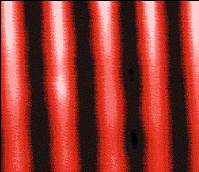Kevin Robinson
NEW HAVEN, Conn. -- Chemically etching a near-field optical fiber probe tip has enabled researchers at Yale University to improve the scanning rate of a near-field optical microscope. The etching technique, which produces near-field tips of about 70 nm in diameter, increases the tips' optical power to the microwatt range. This increase in optical efficiency has allowed the scientists to scan images at 10 fps with optical signal-to-noise ratios that portend video rate scanning.
Better resolution
The near-field optical microscope is important because it breaks the diffraction limit of classical optics. Piping illumination through an optical fiber tapered to a diameter smaller than one wavelength of the imaging light and scanning the sample at a distance less than one wavelength, the microscope skirts the diffraction that chains traditional microscopes.

Increased throughput allows researchers to
create near-field optical images of 100-nm lines and spaces at a rate of 10 fps.
|
The scanning rates of these microscopes are dependent on the throughput of the optical fiber tips, which range in size from 50 to 100 nm. According to Scott Bukofsky, a PhD candidate in Robert Grober's lab at Yale, typical throughputs are about 1026. At this level, the scanning moves slowly to collect enough photons to make an image. "If you want to go faster," Bukofsky said, "you have to increase the amount of light coming from the probe."
There are two methods of making the tiny probes from an optical fiber -- pulling or chemical etching. Pulling a fiber involves heating it and stretching it to the required size. Bukofsky said this method creates higher losses because it stretches both the fiber's cladding and core.
"The core gets too small to support the optical mode propagating down it," he said. "This happens hundreds of microns before the tip's end, causing the light to leak out and interact with the metal coating the fiber. To make a more efficient probe you must maintain the core integrity right to the end."
Chemical etching allows scientists to taper the fiber's cladding and leave the core intact until very close to the tip's end. To date, Bukofsky and Grober have etched tips to 70 nm and achieved optical throughputs in the area of 1022 or 1023. Bukofsky said that these throughputs have increased the optical signal-to-noise ratio so much that video rate scanning is soon to follow.